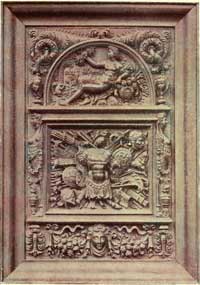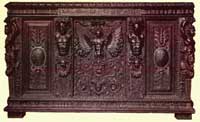French Renaissance Furniture
The French Renaissance furniture is characterized by the rapid adoption of the decorative models of antiquity, under the influence of the Italian artists, who were already using them for some hundreds of years. It should be mentioned that initially, only the decorative motifs were imported, not the form of the furniture, which will change much latter.
The Italian techniques of colored marquetry, painting of panels, or intarsia were not immediately adopted by the French cabinet-makers, who continued to use the carving in relief.
The early French Renaissance furniture preserved the old motifs, and there were works in the purest Gothic style still being executed at the beginning of the 16th century. As the French artists became familiar with the works of Michelozzo and Mantegna, the double corbels, and motifs like the dolphin or the siren, began to appear in the works of the French cabinet-makers.

French Renaissance Panel - Sambin School
The evolution of furniture during the French Renaissance can be followed by looking at the degree of Gothic still merged in the new style. At the beginning of the reign of Francis I, the new furniture style became predominant, with the details and ornaments imposed on the old foundations of the Gothic character. The French furniture of the Renaissance period displayed a lighter ornamentation, with a less conservative carving. The craftsmen did not simply copy the Italian designs, but modified them with a refined taste.
The new decorations employed by the French furniture makers were the columns having capitals with floral motifs, carved figures in relief, dolphins, flat mouldings (bandelettes). The old pointed arch was rarely used in the cornices or mouldings, until it finally disappeared. Early in the period, mainly oak was used. Eventually, walnut became the preferred wood.
The French Renaissance chairs were more graceful and lighter than the Italian ones. Their seats were broad, with straight legs, and the backs lower than those of the Italian models. The use of cushions was followed by upholstery. Carving was similar to their Italian counterparts, but often with spiral or turned legs and supports. Some chests and cabinets were less architectural in character and were sometimes furnished with drawers. Overall, by the end of the reign of Francis, the Italian style triumph was complete.
It is at the beginning of the reign of Henry II when the transformation, the emancipation from the Italian style began, accomplished by the French artists according to their own ideas and taste. The result was a style with a completely original character. It was called, after the name of the monarch, the Henry II furniture style.
The purely French Henry II style is truly defining the furniture of the Renaissance period in that country. It was the result of two schools, the school of du Cerceau in Île de France, and that of Hugues Sambin in Burgundy.
The works of the school of du Cerceau show grace of line and fine details, while the Burgundian style suggested richness through lavish carving. The former was strongly influenced by the sculptures of Jean Goujon, especially gracious mythological Dianas, the latter preferred the muscular mythological subjects like satyrs, or lions’ heads, and eagles.
The French Renaissance furniture entered a period of decline by the end of the reign of Henri IV. No principles of construction or decoration were followed, and the results were highly ornamented, but poorly designed pieces of furniture. However, the shell ornamentation was introduced, the forerunner of rococo (rocaille et coquille, rock and shell).

